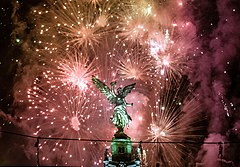New Year's Day
| New Year's Day | |
|---|---|

Fireworks in Mexico City at the stroke of midnight on New Year's Day, 2013
|
|
| Observed by | Users of the Gregorian calendar |
| Significance | The first day of the Gregorian year |
| Celebrations | Making New Year's resolutions, church services, parades, sporting events, fireworks |
| Date | January 1 |
| Next time | January 1, 2018 |
| Frequency | Annual |
| Related to | New Year's Eve, Christmastide |
New Year's Day, also called simply New Year's or New Year, is observed on January 1, the first day of the year on the modern Gregorian calendar as well as the Julian calendar. In pre-Christian Rome under the Julian calendar, the day was dedicated to Janus, god of gateways and beginnings, for whom January is also named. As a date in the Gregorian calendar of Christendom, New Year's Day liturgically marked the Feast of the Naming and Circumcision of Jesus, which is still observed as such in the Anglican Church and Lutheran Church. In present day, with most countries now using the Gregorian calendar as their de facto calendar, New Year's Day is probably the most celebrated public holiday, often observed with fireworks at the stroke of midnight as the new year starts in each time zone. Other global New Years' Day traditions include making New Year's resolutions and calling one's friends and family.
Mesopotamia (Iraq) instituted the concept of celebrating the new year in 2000 BC, celebrated new year around the time of the vernal equinox, in mid-March. The early Roman calendar designated March 1 as the new year. The calendar had just ten months, beginning with March. That the new year once began with the month of March is still reflected in some of the names of the months. September through December, our ninth through twelfth months, were originally positioned as the seventh through tenth months (septem is Latin for "seven," octo is "eight," novem is "nine," and decem is "ten.")
...
Wikipedia
